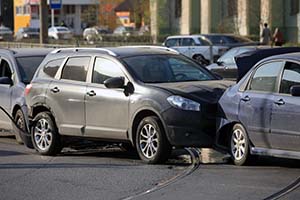 Car accidents are dangerous events that leave everyone involved vulnerable to serious injuries and other considerable financial and emotional damages. However, when more than two cars are involved in a traffic accident, it is that much more dangerous – and the car accident claim is that much more complicated. If you’ve been injured in a three-car accident, determining fault in the matter is paramount, and having an experienced Kentucky car accident attorney in your corner is the best path forward.
Car accidents are dangerous events that leave everyone involved vulnerable to serious injuries and other considerable financial and emotional damages. However, when more than two cars are involved in a traffic accident, it is that much more dangerous – and the car accident claim is that much more complicated. If you’ve been injured in a three-car accident, determining fault in the matter is paramount, and having an experienced Kentucky car accident attorney in your corner is the best path forward.
Chain-Reaction Accidents
Accidents that involve more than two vehicles are often called chain-reaction accidents. This is because such accidents typically begin with a two-car accident that turns into a chain reaction when a third car becomes ensnared in the crash in one way or another – either because the originating accident created an unavoidable barrier to safe passage on the road, because the force generated by the originating accident caused one of the original two cars to hit or be hit by a third, or because a third driver’s negligence caused him or her to plow into the originating accident.
These accidents are often referred to as pileups, and there are several common examples:
Scenario 1: The second car hits the first at a stoplight
A second car hits a first car that is stopped at a stoplight or a stop sign (or is stopped at an intersection for any other reason), pushing that first car into the intersection – only to be hit by a third car moving through the intersection at the time. This is an accident where the driver of the second car may be deemed fully at fault (if the driver of the third car had no safe recourse at the moment that the accident happened).
Scenario 2: The first and second cars are stopped at an intersection
Two cars are stopped at a stoplight, a stop sign, due to an accident, or for any other reason, and a third car – driven by a motorist who is driving too fast and/or is too distracted to come to a safe stop in response – plows into the second car, which subsequently pushes into the first. This is an instance when the driver of the third car will likely be deemed fully responsible.
Scenario 3: The first car must slam on its brakes
The first car is required to slam on his or her brakes due to an accident, animal in the road, or for any other reason, and a second motorist – who is following too closely, is driving too fast, and/or is not paying adequate attention – plows into the first, only to be slammed into by a third car whose driver is similarly negligent. This is a pileup in which fault for your damages (as the first driver) will be shared by both the second and third drivers.
Scenario 4: The first car hits the second in an intersection
A second car hits the first car in an intersection (generally due to negligence on the part of the second driver – unless the first driver ran a red light or engaged in some other negligent practice that leaves him or her in the intersection when he or she should not be), and a third car, whose driver is following too closely, is driving too fast, and/or is not paying adequate attention, plows into the first two. This is another example of when both drivers two and three are likely to share fault for your damages.
Whatever you call them – pileups, multi-car accidents, chain-reaction accidents, or anything else – these accidents are even more dangerous than accidents involving two cars while the associated claims are even more complicated.
Common Causes of Three-Car Pileups
Pileups can happen for many reasons, but they generally hinge on driver negligence:
Excessive Speed
When motorists drive too fast, they make car accidents more likely, and they help to ensure that any ensuing accidents will be life-threatening. Driving at a safe speed is relative to the conditions on the road, and if the weather is bad, visibility is low, and/or the road is poorly maintained, motorists are responsible for slowing down accordingly. Pileups often happen when one driver’s excess speed causes an accident and a third driver’s excess speed leaves him or her unable to respond safely.
Tailgating
Tailgating refers to riding the bumper of another driver’s vehicle, and it ensures that the rear driver has neither the distance on the road nor the time necessary to slow down or stop safely if the need arises. The subsequent shove experienced by the forward vehicle often pushes it into harm’s way – only to be hit by a third vehicle.
Unsafe Lane Changes
When drivers change lanes without paying careful enough attention, without signaling appropriately, or otherwise dangerously, they help to create mayhem on the road, and when traffic is heavy, they make chain-reaction car accidents far more likely.
General Distraction
Motorists who don’t pay attention to what is going on around them on the road are not up to the task of driving safely, and they are often the cause of car accidents. When a distracted forward driver causes a car accident, it sets things up nicely for a distracted rear driver to plow into the wreckage and create a pileup. Drivers are responsible for driving safely – come what may – and failing to react safely to someone else’s distraction/negligence does not mitigate the driver’s own distraction/negligence. Texting behind the wheel is the deadliest distraction of all.
Turn to an Experienced Kentucky Car Accident Attorney to Get the Settlement You Deserve
If you have been injured in a pileup that was caused by the negligence of one or more other drivers, Kentucky car accident attorneys at Flora Templeton Stuart Accident Injury Lawyers have represented hundreds of car accident victims involved in multiple vehicle collisions and have collected millions for their injured clients over 45 years. You can call or chat with our top lawyers 24/7. Remember we only get paid if we win your case. You never need to leave your home if you’ve been in an accident because our attorneys travel to you. You can call us 24/7 at 888-782-9090.
